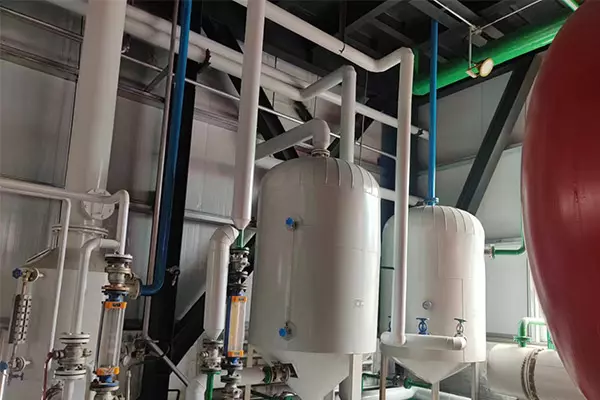
Introduction
The peanut oil refining process is a critical process to transform crude peanut oil into a high-quality, edible product. (Read more: how to make peanut oil. >>) The refining process consists of four key stages: degumming, deacidification, decolorization, and deodorization. The refining process can be conducted using batch-type, semi-continuous, or fully continuous systems, each suited for different production capacities and investment levels.
Huatai Peanut Oil Refining Machine Capacities and Advantages
Batch-Type Refining Machine
- Capacity: Less than 20 tons per day
- Advantages: Ideal for small oil mills or plants with a small investment. It requires minimal space, is simple and flexible to operate, and can easily switch between different types of oils.
Semi-Continuous Refining Machine
- Capacity: 20-50 tons per day
- Advantages: Incorporates a deodorization tower, allowing the deodorization section to operate automatically and continuously. This results in high efficiency and superior refining effects. Suitable for those with a moderate budget.
Fully Continuous Refining Machine
- Capacity: More than 50 tons per day
- Advantages: Designed for large-scale peanut oil processing plants. It features extensive auxiliary equipment, enabling automatic and continuous operation of all refining stages. This system demands a significant investment and is recommended for large-scale operations.

Detailed Peanut Oil Refining Process
Step 1: Degumming
Crude peanut oil is pumped from bulk storage and preheated using an oil/oil heat exchanger, ensuring efficient heat transfer. The oil is then transferred to a buffering tank equipped with a mechanical agitator and steam heating coils for homogenization.
In the hydration tank, hot water is added to the oil continuously, facilitating the maturation of hydratable gums. These gums are separated using a self-cleaning centrifugal separator. The degummed oil undergoes a second round of heating, mixing with hot water, and water washing in another centrifugal separator before being dried under vacuum.
Step 2: Deacidification
The degummed oil, still containing free fatty acids, is treated with an alkali solution to neutralize the acids. This process forms soap stock, which is then separated. The neutralized oil is rewashed with hot water to remove any remaining soap particles and dried to eliminate moisture.

Step 3: Decolorization
The deacidified oil is pumped to a bleaching tank, where it is mixed with white clay or activated bleaching earth as an adsorbent to remove pigments and impurities. The mixture is held and agitated under vacuum conditions, enhancing the bleaching effect. The bleached oil is then filtered using pressure leaf filters and polishing filters to achieve a clear, refined product.
Step 4: Deodorization
The bleached oil is preheated using heat recovery economizers and further heated to 120°C in a de-aerator to remove dissolved air. It is then subjected to high temperatures (240-250°C) in a multi-compartment deodorizer. Under high vacuum and with the help of sparging steam, volatile compounds, free fatty acids, and odoriferous substances are distilled off.
The deodorized oil passes through regenerative heat exchangers and cooling water heat exchangers, lowering its temperature to below 55°C. The final deodorized oil is filtered through polishing filters, ensuring a high-quality, odor-free product ready for consumption.
Benefits of Continuous Refining Sections
Continuous Degumming & Neutralization
Ensures efficient removal of gums and phospholipids through precise heating and water addition. The centrifugal separators and vacuum driers optimize the degumming and neutralization processes.
Continuous Bleaching
Combines dry and wet bleaching techniques for multipurpose applications. The high-speed oil earth mixer ensures effective mixing, while pressure leaf filters and polishing filters guarantee a clear and refined oil. (Read more: palm oil bleaching process. >>)

Continuous Low Temperature (TFT) Deodorizing
The multi-compartment vertical deodorizer, designed with special trays, ensures uniform distillation and efficient removal of volatile substances. The counter-current flow design and vacuum balance tray enhance heat recovery and deodorization efficiency.
Huatai Peanut Oil Refining Machine
Huatai Oil Machinery Co., Ltd. is a comprehensive cooking oil refining machine manufacturer, offering process design, technology research and development, manufacturing, sales, and after-sales service. We provide three types of peanut oil refining machines:
- Batch-Type Refining Machine: 1-20 TPD
- Semi-Continuous Refining Machine: 20-50 TPD
- Fully Continuous Refining Machine: 50-600 TPD
No matter the type of refining equipment you need, we can provide a suitable solution to meet your requirements. Contact us now for a free custom plan and the best price.

Conclusion
The peanut oil refining process is a crucial process that transforms crude oil into a high-quality, consumable product. By understanding the detailed steps and the advantages of different refining systems, you can select the most appropriate equipment for their needs. With Huatai’s advanced technology and comprehensive services, we are committed to helping you produce top-tier peanut oil that meets national standards. If you want to know more about peanut oil refinery, please contact us at 0086-159-3728-9608.
Get your best price
- Engineer quick quote
- The overall delivery speed is fast
- Financial choice
- Low installation costs and cost savings
30 years+ of oil mill plant R&D
More than 56 innovative technologies
